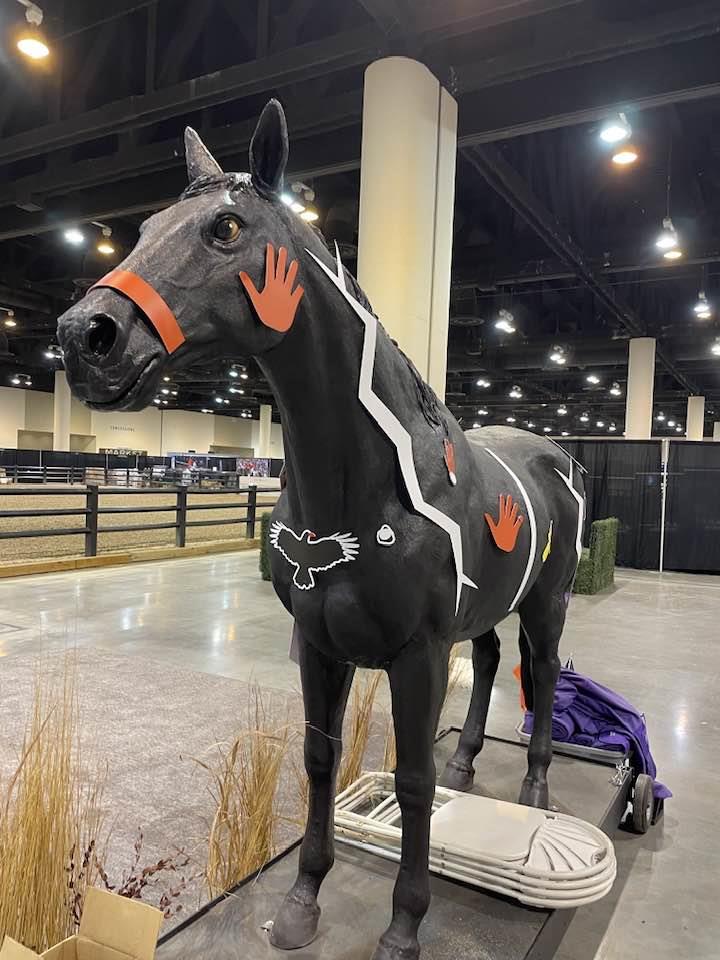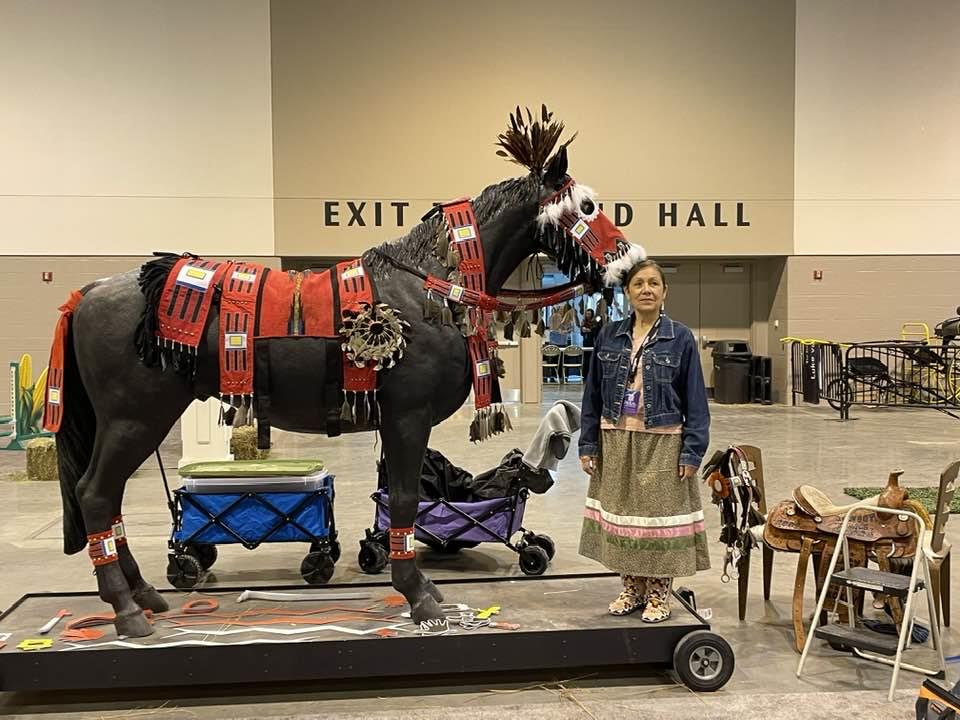In April, the 2023 FEI World Cup™ Finals in Omaha, Neb., served as an exciting equestrian event on U.S. soil. The event had a theme that incorporated Native American culture and their involvement with horses. For Native American Heritage Month, US Equestrian spoke with Julie Boilesen, Omaha Equestrian Foundation’s Chief Executive Officer, and Steve Tamayo, Bluebird Cultural Initiative’s founder, to learn how the event’s theme came about, how it complemented the event, and what they hoped to achieve with the theme.
Creation of 1723 Theme
Back in 2020, Boilesen was contemplating a theme for the World Cup Finals. She spent time brainstorming and coming up with a list of unique aspects of Omaha to help frame her plans for the event.
“I like a theme; I like a story because it makes it easier to actually execute when you know what the story is and you're clear on your plan,” said Boilesen.
When social justice issues arose in 2020, Boilesen said she began thinking about who in the Omaha community was involved with horses and doesn’t often have a voice.
“The idea came up that often, Native Americans don't have a voice; they don't tell their own story,” said Boilesen. “I put them on the list, but I was not very confident in being able to execute that theme because you have to have the right partner who can knowledgeably help you navigate the story.”
While spending time with friends, Boilesen received a fortuitous recommendation to connect with Tamayo. After Boilesen met Tamayo for lunch, she said she knew she had found the right person to help her bring the theme to life.
Tamayo founded the Bluebird Cultural Initiative, a nonprofit organization focused on sharing the history of Native Americans from the Great Plains and revitalizing cultural practices. Bluebird offers a variety of activities, ranging from drum groups to singing to sewing to Lakota language classes.
“One thing about Bluebird is everything's free. The grant money allocated to us allows us to purchase the material items that we need to continue on this path,” said Tamayo of Bluebird’s programs. “We all gather collectively to help the community strengthen culturally.”
In addition to his involvement with Bluebird, Tamayo is a cultural specialist for Omaha Public Schools and covers the Native Americans of the Great Plains.

(Courtesy of Steve Tamayo)
“I create specific lesson plans pertaining to indigenous people: our dwellings, our designs, symbology, numerology, and color concept,” said Tamayo. “I teach about foraging compared to harvesting and planting, because we're not farmers, we’re foragers.”
With Tamayo’s great depth of knowledge and personal experience, he and Boilesen collaborated on the World Cup Finals theme. Tying in some of the big stars of the event—the horses—became one aspect of the theme. Tamayo and Boilesen wanted to promote the horse nation.
“In all indigenous languages, animal doesn't exist in our vocabulary. They're a nation within a nation. So, we identify them as the horse nation, the buffalo nation, the eagle nation—never animal,” said Tamayo. “In our language, we identify all the beings as wamák?aška?, which are ‘the beings that roam the earth.’ That's the two-leggeds, the four-leggeds, the eight-leggeds, the winged, and the water, so they're all relatives of ours.”
In addition to the horse nation, 1723 became another part of the event’s theme. Boilesen noted that 300 years ago was the right timeframe for the horse nation and Native Americans to be present in the region of Omaha.
“It gave us something to focus on, and I think it was a great partnership,” said Boilesen. “I think it brought something special to the event.”
Boilesen and Tamayo worked together to compile a narrative. Boilesen said the narrative ended up serving as about 90% of the script that the announcer used during daily evening competition presentations. The narrative also provided a clear direction while working with Turnpost Creative Group, a local advertising agency.
“Steve was there for our photo shoot. I would get things the way I liked them, and he would approve images,” said Boilesen. “I would always run things by Steve to make sure they were correct.”
Native American symbols were incorporated in a variety of branded materials, even down to the scarves and ties for the officials. With the branding in place, Tamayo did a trial run with some of the education materials, using a full-sized fiberglass horse painted with magnetic paint to demonstrate Native American symbols. Boilesen said local students loved the demonstration, and Tamayo grew the education plans from there.
Even with the branding and educational components, Boilesen said the competition was to remain the focus.
“We didn't want to take away from the sport,” said Boilesen. “You wanted it to be complimentary and try to do it in a balanced way.”
Showtime in Omaha
When it was time for the World Cup Finals, Tamayo and his team of presenters had a full schedule of educational presentations and demonstrations planned throughout the week. Boilesen said the Omaha Equestrian Foundation covered the costs of the advertising, Steve’s time, and grants for all the artists and performers to make sure that the theme could come to fruition.
“Steve brought in Native Americans from tribes all over the Midwest, all over the country,” said Boilesen. “I thought that was very special. There were actually three generations of family there from Steve's family: Steve, his daughter, and his grandson.”
Tamayo spoke about the second coming of the horse in the U.S. following the extinction of prehistoric horses thousands of years ago.
“The Pueblos were actually able to push back the conquistadors in 1680. They rounded up and they kept all their horses,” said Tamayo. “Once they kept the horses, they drove the Spaniards back on foot towards Mexico. They released the horse nation to the north, and they set fires and they chased them so that they would head up north because the Spaniards were using horses as part of their weapons to ride into the villages.”
Tamayo explained that once Lakota people captured horses from the Omaha people in 1709, it changed their way of life. Travoys that were previously hitched to dogs were then hitched to horses, allowing the Lakota people to carry more belongings and travel greater distances as nomadic people. Horses also helped make hunting buffalo much easier.
Though their lifestyle has changed with the passing of time, the Lakota people are still grateful for their horses.

(Courtesy of Steve Tamayo)
“Today, we're rejoicing,” said Tamayo. “We have parades with our horses. We dress our horses like you wouldn't believe. Some of the regalia that we create is worth $100,000 because of the beadwork and the quill work.”
In addition to parades with their horses, Tamayo said the Lakota people make music about their horses.
“We still compose our own songs, and we identify the specific horses by accomplishments and deeds carried out,” said Tamayo. “All of us have spirit names that only come out during specific times. It's not something that we print and we wear, so those are very special names to us. Even our horses have spirit names, so understanding that, we incorporate those specific spirit names into the songs.”
Horses are still incorporated into the lives of many Native American people, with equine therapy programs being located on several reservations. Tamayo noted that it is often the horse choosing the rider in these programs, rather than the other way around.
“We put our youth in the center by themselves and we let the horse choose that person. And who knows, they are like, ‘How long do I got to stay there?’ ‘The horse will tell you,’” said Tamayo. “For the horse to have the opportunity to choose the two-legged is a rarity. But to be able to tell the youth and engage and encourage them to understand our traditional ways of virtues and values and understanding compassion, it's also a rarity nowadays.”
Along with the insights that Tamayo and his team of presenters shared during the World Cup Finals, a handful of Native American vendors sold the products from their small businesses.
“It was an opportunity for them to showcase their entrepreneurship and what they've been doing because it's all natural,” said Tamayo.
Boilesen noted that 300 gift bags were assembled for the World Cup Finals, and products from the Native American vendors were included in the bags.
“All of them either received soap from Lakota Made or lip balm from the Honey Lodge as part of their gift because we did want to make sure that everybody got to take home a little piece with them,” said Boilesen.
In addition to the education and vendors areas, music was another significant presence for the Native American people at the World Cup Finals.
“With the exception of the anthem, every single musical performance was a Native American performance,” said Boilesen.
Telling the Absent Narrative
While having Native American heritage on display during the World Cup Finals added cultural and educational components to the event, it was about more than that for Tamayo and Boilesen.
“I wanted the absent narrative to be told because nobody's ever asked us,” said Tamayo. “When you read and you learn about American history, it's not our history. Nobody talks about the atrocities committed—of the genocide. There were millions and millions of indigenous people. We all know that. With the census of 1890, there were only 200,000 left in the country.”
Tamayo said he wanted the world to know that the Native American people and their culture are still here—their stories, songs, and ways of life.
“It's a different perspective when you look at it through our lens. So as a cultural instructor, it's a wonderful opportunity for me to tell my stories. It's a perfect time too because nobody wanted to hear this 20 years ago now.”
Boilesen hoped that the theme of the World Cup Finals served as a reminder to attendees.
“It’s a reminder that there are tremendous horsemen and women throughout the world who experience horses in a different way, and that Omaha and the Midwest are unique and special places, partially because of this heritage and this story. The name Omaha is a native word; Nebraska is a native word. You can't get much clearer of where our heritage is.”
Boilesen believed that an equestrian event bringing people together from around the world offered an opportunity to celebrate horses as well as learn something about the local culture.
“The event had all these people who were here who have this communal love and interest in horses, and maybe they also heard about somebody else's culture and someone else's history from something other than a movie,” said Boilesen. “I just love this place. I'm very proud of being from Nebraska. And I wanted to tell a story that was true to the place.”


